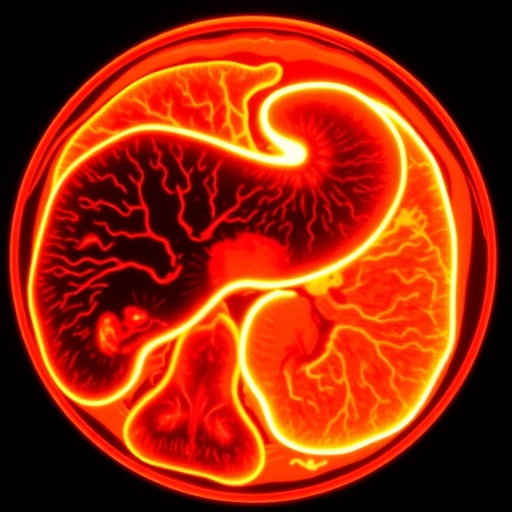In a groundbreaking advancement poised to revolutionize the treatment of stroke and related neurological injuries, researchers have engineered a nanomaterial mimicking endothelial nitric oxide synthase (eNOS), capable of specifically reversing cerebral ischemia-reperfusion injury. This innovative approach not only promises targeted therapeutic intervention but opens new avenues for mitigating the devastating aftermath of stroke, a leading cause of disability and mortality worldwide.
Cerebral ischemia-reperfusion injury arises when blood supply to the brain is blocked (ischemia) and subsequently restored (reperfusion), triggering a cascade of detrimental biochemical events. While reperfusion is critical for tissue survival, it paradoxically induces oxidative stress, inflammation, and endothelial dysfunction, collectively exacerbating neuronal damage. The complexity of this pathological process has historically limited the efficacy of conventional therapies, emphasizing the urgent need for strategies that can precisely counteract these molecular and cellular disruptions.
The team designed a nanomaterial that functionally replicates eNOS, an enzyme primarily responsible for producing nitric oxide (NO) in the vascular endothelium. NO plays a pivotal role in maintaining vascular homeostasis, exerting vasodilatory, anti-inflammatory, and anti-thrombotic effects. However, during ischemia-reperfusion events, eNOS activity is often uncoupled or diminished, resulting in reduced NO bioavailability and contributing to vascular injury and inflammation. By crafting a nanoengineered material with eNOS-like catalytic activity, the researchers aimed to restore NO levels in affected cerebral vessels precisely and effectively.
Fundamental to the nanomaterial’s design was its capability to generate NO under physiological conditions, mimicking natural enzyme kinetics. The study thoroughly characterized the physicochemical properties of the material, confirming its biocompatibility and stability in biological environments. Moreover, the nanomaterial demonstrated potent catalytic activity in generating NO from endogenous substrates, a critical advancement for in situ therapeutic application.
Subsequent in vitro experiments revealed the nanomaterial’s protective effects against endothelial cell dysfunction induced by ischemia-reperfusion mimicking conditions. With enhanced NO production, treated endothelial cells showed improved survival rates, reduced oxidative stress markers, and preserved barrier integrity, hallmark signs of restored vascular function. These promising cellular-level outcomes laid the foundation for progressing to in vivo evaluations.
In vivo studies conducted in animal models simulating cerebral ischemia-reperfusion injury demonstrated remarkable functional recovery upon treatment with the eNOS-like nanomaterial. Behavioral assessments indicated significant neurological improvement, correlating with reduced infarct volumes and attenuated neuroinflammation observed through histopathological analysis. Importantly, systemic side effects were minimal, underscoring the nanomaterial’s specificity and safety profile for cerebral applications.
One of the most striking findings was the nanomaterial’s ability to target the brain’s vasculature selectively. By leveraging tailored surface modifications, the researchers enhanced the nanomaterial’s ability to cross the blood-brain barrier and localize within cerebral endothelial cells. This targeted delivery mechanism minimizes off-target effects, a common limitation of conventional pharmacotherapies that often result in systemic toxicity.
Mechanistically, the nanomaterial intervenes at multiple stages of ischemia-reperfusion pathology. In addition to restoring NO levels and promoting vasodilation, it dampens inflammatory signaling pathways by modulating endothelial expression of adhesion molecules, preventing leukocyte adhesion and transmigration. These effects collectively contribute to preserving microvascular integrity and preventing secondary neuronal injury.
The research also highlighted the critical balance maintained by the nanomaterial between NO production and reactive oxygen species (ROS) scavenging. Excessive ROS generation during reperfusion exacerbates cellular damage, but the nanomaterial’s catalytic components possess intrinsic antioxidative properties, neutralizing ROS and further mitigating oxidative injury. This dual functionality reinforces its therapeutic potency.
From a translational perspective, this eNOS-like nanomaterial represents a versatile platform adaptable to other forms of endothelial dysfunction beyond cerebral ischemia, such as cardiovascular diseases and peripheral vascular disorders. Its modular design allows for customization according to disease-specific molecular signatures, heralding a new class of nano-biohybrid therapeutics.
Importantly, the study also addressed the pharmacokinetics and biocompatibility challenges by employing biodegradable materials and optimizing dosing regimens to maximize therapeutic window while minimizing accumulation in off-target organs. This comprehensive optimization is crucial for regulatory approval and eventual clinical deployment.
Looking forward, the authors envision integration of this nanomaterial into multimodal therapeutic strategies combining thrombolytic therapies or neuroprotective agents, to synergistically enhance stroke treatment outcomes. Moreover, ongoing studies aim to refine nanoparticle functionalization for real-time monitoring of therapeutic efficacy through imaging modalities.
The significance of this work extends beyond its immediate clinical implications; it exemplifies how biomimetic nanotechnology can bridge molecular biology and therapeutic engineering, translating intricate endothelial biology into tangible medical solutions. By harnessing the natural protective mechanisms of eNOS via nanomaterials, the research opens new paradigms in the management of ischemia-reperfusion injury.
Given the global burden of cerebrovascular diseases and limited treatment options, this study offers renewed hope for patients afflicted by stroke. Its innovative approach not only addresses unmet clinical needs but also sets a precedent for designing enzyme-mimicking nanotherapeutics targeting complex vascular pathologies.
In conclusion, the development of an eNOS-like nanomaterial capable of specifically reversing cerebral ischemia-reperfusion injury marks a transformative milestone in nanomedicine and cerebrovascular therapy. The convergence of catalytic nanoengineering, targeted delivery, and detailed mechanistic insight presents a powerful therapeutic modality with potential to significantly improve neurological outcomes and quality of life for millions of patients worldwide.
Subject of Research: Development of an endothelial nitric oxide synthase (eNOS)-like nanomaterial for targeted reversal of cerebral ischemia-reperfusion injury.
Article Title: An eNOS-like nanomaterial for specific reversal of cerebral ischemia-reperfusion injury.
Article References:
Wang, S., Xiang, Y., Shi, X. et al. An eNOS-like nanomaterial for specific reversal of cerebral ischemia-reperfusion injury. Nat Commun 16, 9456 (2025). https://doi.org/10.1038/s41467-025-64518-4
Image Credits: AI Generated
Tags: advancements in stroke rehabilitationcerebral ischemia-reperfusion injury reversalendothelial nitric oxide synthase mimicengineered materials for neurological disordersinflammation and neuronal damageinnovative stroke therapy approachesnanomaterial for stroke treatmentneuroprotection through nanotechnologynovel strategies for ischemic brain injuryoxidative stress in stroke recoverytargeted interventions for brain injuryvascular homeostasis and nitric oxide




